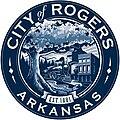Rogers, Arkansas | |
|---|---|
 Clockwise from top: Downtown Rogers, the Centennial Caboose, Lake Atalanta, Pinnacle Hills Promenade, War Eagle Mill | |
| Nickname: "The City" | |
| Motto: "Where Possible Lives" [1] | |
 Location of Rogers in Benton County, Arkansas. | |
| Coordinates: 36°19′51″N94°06′28″W / 36.33083°N 94.10778°W | |
| Country | United States |
| State | Arkansas |
| County | Benton |
| Established | 1881 |
| Incorporated | June 6, 1881 [2] |
| Named after | Captain Charles Warrington Rogers |
| Government | |
| • Mayor | Greg Hines (R) [3] |
| Area | |
| 39.07 sq mi (101.18 km2) | |
| • Land | 38.90 sq mi (100.74 km2) |
| • Water | 0.17 sq mi (0.44 km2) |
| • Urban | 42.01 sq mi (108.81 km2) |
| Elevation | 1,352 ft (412 m) |
| Population | |
| 69,908 | |
| 75,639 | |
| • Density | 1,877/sq mi (724.7/km2) |
| • Urban | 172,585 |
| • Metro | 576,403 |
| [7] | |
| Time zone | UTC−6 (Central (CST)) |
| • Summer (DST) | UTC−5 (CDT) |
| ZIP codes | 72756-72757-72758 |
| Area code | 479 |
| FIPS code | 05-60410 |
| GNIS feature ID | 2404644 [5] |
| Website | rogersar.gov |
Rogers is a city in Benton County, Arkansas, United States. Located in the Ozarks, it is part of the Northwest Arkansas region, one of the fastest growing metro areas in the country. [8] Rogers was the location of the first Walmart store, whose corporate headquarters is located in neighboring Bentonville. [9] The city was also the location of the first 7 Brew coffeehouse. [10] Daisy Outdoor Products, known for its air rifles, has both its headquarters and its Airgun Museum in Rogers. The city houses a popular shopping center, the Pinnacle Hills Promenade, and a music venue, the Walmart AMP, that has housed performances by big-name artists and local performers. [9]
Contents
- History
- Historic commerce
- Geography
- Climate
- Demographics
- 2020 census
- 2010 census
- 2000 census
- Culture
- Annual cultural events
- Parks and recreation
- Media
- Sports
- Government
- Law enforcement
- Public safety
- Politics
- Education
- Primary and secondary education
- Higher education
- Infrastructure
- Aviation
- Transit
- Highways
- Utilities
- Notable people
- See also
- References
- External links
As of the 2020 US Census, [6] the city had a population of 69,908. In 2022, the estimated population was 72,999 [6] making it the sixth-most populous city in the state. Northwest Arkansas is the 98th biggest metropolitan area by population in the United States, with 576,403 inhabitants as of the 2022 U.S. Census Estimate. [11]








